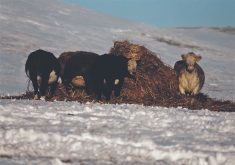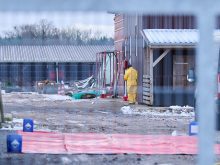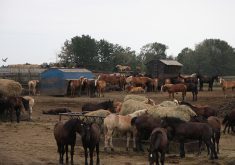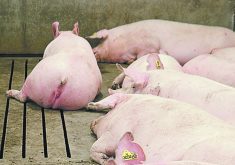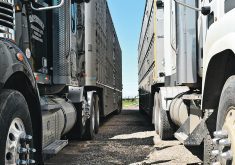An undercover video capturing poor treatment of pigs at a Red Deer assembly yard will be used as an employee training tool, says the chair of Western Hog Exchange.
Brent Moen said staff and employees would go through the video frame by frame to help learn how to better handle hogs at the assembly yard.
“We’ve asked every one of our employees to watch the video,” he said.
Animal activist group Mercy for Animals recorded the video over a nine-week period while a member was working at the assembly yard. Parts of the video were given to the television program W5 and aired mid-October.
Read Also

Farming Smarter receives financial boost from Alberta government for potato research
Farming Smarter near Lethbridge got a boost to its research equipment, thanks to the Alberta government’s increase in funding for research associations.
“We have requested a full version. We don’t know what happened leading up to the violations, or after,” said Moen.
“Every one of our staff are really sick about this. There is a high level of remorse.”
One employee has been fired and two others suspended since Western Hog Exchange officials first watched the video in September.
“We’re using this as an opportunity to improve our delivery and performance standards.”
Moen said the farmer-owned marketing agency has clear animal standards for handling livestock. Abuse is not tolerated.
It has hired two outside consultants since learning about the video to audit the facility and training manuals and recommend improvements.
“We have a zero tolerance limit for abuse,” said Moen.
“We’re watching an awfully lot closer than we were doing before.”
About 40,000 hogs a week arrive at the assembly yards, some for slaughter at the Red Deer facility.
The older sows and boars are reassembled and shipped to Manitoba, a 12-hour truck ride. There they are offloaded, reassembled and trucked to slaughter plants in the United States. Western Canada has no cull sow slaughter plants.
He said it’s not just staff at the assembly yards who need to shoulder the blame for the mistreatment of pigs shown in the video. Farmers and truck drivers also need to accept responsibility.
In the video, workers were shown hitting a downed sow in an effort to move the animal. Moen said farmers must evaluate if cull animals are in good enough shape to be shipped.
“The farmer must understand and evaluate the animal and say, ‘is this animal in good enough shape to go?’ ”
He said he cringed when he saw the poor shape of the sow trying to be moved during the video.
“Why the hell was that thing shipped?”
Truck drivers also have the authority to refuse to haul animals they believe are in poor condition and shouldn’t be going to market.
“Everyone in the chain has to take responsibility.”
The Canadian Food Inspection Agency said verifying that the industry treats animals humanely during transport and slaughter is a responsibility it takes seriously.
The agency had inspectors at the assembly yard.
“Animal abuse is unacceptable, and we do not tolerate it under any circumstances,” it said.
CFIA said it was unable to view the entire video footage to help carry out a detailed investigation.
“Regardless, we promptly launched an internal review by a team of ex-perts to determine if federal rules were broken and if suitable inspection actions were taken,” it said.
“The review team will provide its findings to senior officials and appropriate actions will be taken.”
Alberta Farm Animal Care said it supports the actions of the Western Hog Exchange and the CFIA to address the problems identified in the televised video footage.
“AFAC believes all animals should be treated with respect and compassion according to responsible and humane animal care practices throughout their lifetimes,” Dr. Angela Greer, acting executive director of AFAC, said in a news release.
“We cannot tolerate any failure to uphold the high standards of animal welfare that so many industry organizations and individual producers have worked hard to establish and continually improve.”





